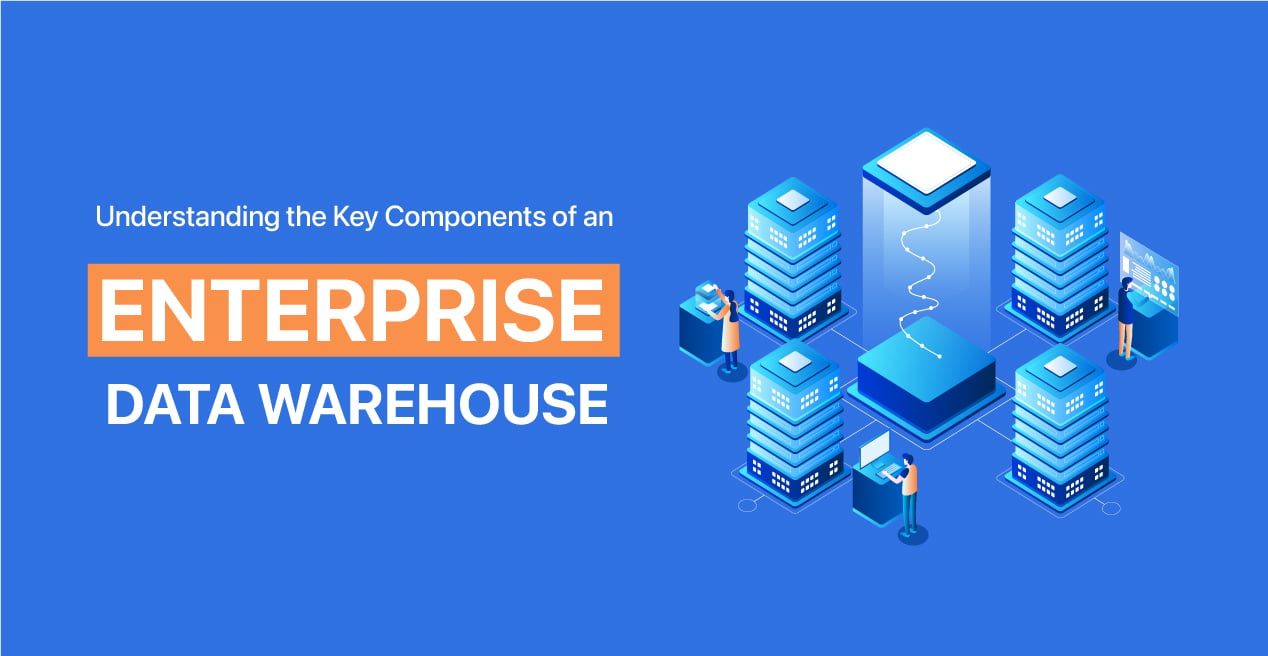Introduction
For businesses looking to revamp their digital assets holding capacity, enterprise data warehouses are great tools to get started with. Modern EDWs help these enterprises achieve data consistency, efficiency, and scalability. These data warehouses are versatile and can be deployed either on-premises or in the cloud, each with its advantages and functionality. Let’s have a look at EDWs in detail.
What is an Enterprise Data Warehouse?
In computing, an enterprise data warehouse is a relational data warehouse(EDW) that holds a company’s business data, including information about its customers, data analytics, and reports. An EDW tool maps actionable insights into data collected and aggregated from more than one source and acts like a repository for wider access and analyses. Similar to a physical goods warehouse, the data stored in such a type of digital warehouse are often one of a business’s most valuable assets.
Data Warehouse Vs Enterprise Data Warehouse
The difference between an EDW and a data warehouse is minuscule. While on one hand, EDW is a data warehouse that encompasses all of an organization’s data, a data warehouse often refers to a smaller repository of data that is specific to a business department or one particular workflow. One can further distinguish an Enterprise Data Warehouse based on the following components it possesses.
Key Components of an Enterprise Data Warehouse
A typical EDW consists of the following five components of a data warehouse :
Data Sources
Data Sources encompass data collected from various operational and transactional systems within the organization. Some of them are:
- Enterprise Resource Planning or ERP systems
- Customer Relationship Management (CRM) platforms
- Finance applications
- Internet of Things (IoT) devices,
- Online systems
Staging Area
The staging area is a buffer space that is used to aggregate, clean, and sort data before it is loaded into an EDW. Here, the raw data is converted into a consistent, usable format that is further loaded for analysis and reporting.
Metadata
Metadata is a critical EDW component as it is used to comprehend collected data and label it with information such as:
- The number of times it has been altered or reloaded
- Transformations the data underwent before and after it was loaded into the warehouse
- The overall picture, i.e., the tables, keys, and attributes in the warehouse.
For example: A regular entry in EDW can look like
John 86 20000 53890
This data is not comprehensible unless accompanied by its metadata:
Customer Name: John
SKU Purchase: 86
Purchase Quantity: 20000
Order Amount: $53890
Presentation or Access Space
The presentation space is an interactive space for users to access the data stored in the EDW. This component becomes the medium for analytics, raising a query, generating reports, sharing data, and facilitating efficient strategizing across all levels of the enterprise.
Data Tool Integrations and APIs
- API stands for Application Programming Interface and refers to software with a distinctive application and functionality. An enterprise data warehouse often accommodates many APIs such as Business Intelligence tools, ETL tools, data ingestion, and analytics tools.
These components mark an enterprise data architecture and warrant the various benefits like centralization and unification of data, in-depth analysis, and unlocking potential for various enterprises.
Why do businesses require an enterprise data warehouse?
Let us have a look at all the benefits of enterprise data warehouse brings to the table of any business:
Simplifies data: An EDW provides context, and sorts individual data entries. While ensuring centralization and easy access to data.
Effective marketing: The data warehouse also facilitates tracking the output of marketing campaigns by using many metrics such as conversion ratio, purchase decisions, etc.
Refinement of data: EDW refines data by removing excess or repetitive data. It helps to present data sets in a concise crisp format for easy analytics and reporting.
Protection from data manipulation: Data immutability is given when it comes to investing in an Enterprise Data Warehouse. EDW maps every change that is made to data which in itself is a long process due to stringent authentication to access to that data.
Utmost protection of data: EDW with its inbuilt APIs provides extra security to the company’s data from external threats with the help of various access controls, encryptions, firewalls, and recurring security audits.
High Return-On-Investment: All benefits amount to high ROI for enterprises with an efficient enterprise data warehouse in place and save these businesses more than 5 million dollars annually that comes with data-related security and storage concerns
EDW further equips a company with functionalities such as
- Real-time access to data
EDWs prioritize the extract-load-transform (ELT) strategy over the more widely used extract-transform-load (ETL) paradigm which further enables real-time access to data. ELT strategy further cleans, transforms, and enhances the data before being imported into the warehouse. This helps in the extraction of data straight from the source unaltered, speeding up access to data.
- Clear Customer preference and understanding
With the use of EDWs, a business gets to understand its clientele from all perspectives, improving campaign efficacy, reducing attrition, and ultimately boosting sales. Another use for an EDW is predictive analytics, where teams may utilize scenario modeling and data-driven forecasting to assist marketing and business decisions.
- Data Compliance
EDWs allow data customers to vet data sources while finding errors quickly and conveniently. This ensures that data stored in the warehouse can easily be updated and vetted according to various compliance policies for multiple locations.
- Reduces the need of experts in various tech fields
Non-technical workers in roles outside of marketing, finance, and supply chain management gain from an EDW. For instance, by using data from IoT sensors positioned in current sites, architects and store designers may enhance the consumer experience in new stores by determining which areas of the retail footprint are the most or least engaging.
- Consolidated and centralized data
As mentioned earlier, centralization and consolidation of data are major advantages of EDW. Modern data warehousing allows enterprises to hold the bulk of organized data across different locations and cloud providers. Further quest for data sets becomes easy and can be accessed straight from the warehouse with a help of a simple query.
Other components of an Enterprise Data Warehouse include:
ETL/ELT
ETL/ELT tools that extract, load, and transform (ELT) or extract, transform, load (ETL) and ingest data from source systems and process it until it’s ready for permanent storage. It’s essential to analytics on enterprise levels since businesses need to rely on a variety of data sources with varying models, data kinds, and rates at which information is generated.
Data warehouse database
Enterprise data warehouse databases are sub-relational databases that are filled with integrated, topic-specific corporate data that can be queried analytically using data models. A metadata repository is another feature of this component, which allows an organization to keep a map of its data for convenient management and access.
Data marts
The analytical requirements of particular user groups and departments, such as supply chain management, finance, manufacturing, and sales and marketing, are different. To cater to these different requirements, dimensional data marts are used. Data marts help manage smaller, more relevant datasets, they make data access and analysis easier and faster.
OLAP cubes
The limitations of relational databases are many. Here OLAP cubes further streamline data and hold them in pre-aggregated form. Such a form comes in handy to meet the different analytical needs of enterprise users, the data in OLAP cubes can be manipulated as required by the user.
Conclusion
With the rise in popularity of digitally transformed businesses, the demand for enterprise software development has also skyrocketed. Each day more and more businesses are adopting tools such as Enterprise data warehouses to equip their operations with more efficiency and keep up with ever-evolving tech markets. While it is important to hop onto the bandwagon of digital transformation quickly, it is also important to do so wisely. Looking for the right tech partner is of the utmost importance and OpenXcell is a great enterprise software development company to start with. The company houses expert developers with a lot of experience in the development of software especially for enterprises.









